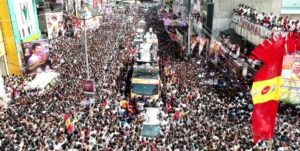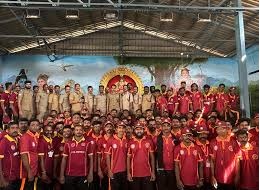Kerala is pulling out all stops to prevent a Karur-like incident when Lionel Messi and team visit the football-crazed state in November.
Published Oct 02, 2025 | 9:00 AM ⚊ Updated Oct 02, 2025 | 9:00 AM

After the Karur and Bengaluru tragedies, Kochi readies for Lionel Messi this November.
Synopsis: Crowd psychology constantly changes and must be closely observed throughout an event. With careful planning, disasters can be avoided—or if they do occur, their scale and casualties can be minimised. Without such planning, the consequences can be catastrophic.
It was meant to be a night of music and celebration. On 25 November 2023, singer Nikitha Gandhi was to light up the stage at Cochin University of Science and Technology (CUSAT)’s tech fest Dishna, drawing a sea of students to the open-air auditorium.
But when a sudden downpour forced hundreds more to rush inside the already packed venue, joy turned to chaos. The rush turned into a nightmare—four young lives lost, 60 others injured. Kerala had witnessed yet another stampede.
The state knows this pain too well. 53 devotees were crushed at Sabarimala in 1999, and over a hundred more at Pullumedu in 2011.
Now, after recent tragedies in Karur and Bengaluru, all eyes are on Kochi—where the world’s biggest crowd-puller, Lionel Messi, is expected this November.
Authorities promise multiple crowd-control plans. But experts warn that a plan alone doesn’t stop a stampede. Human psychology plays a crucial role.
When South First spoke with Dr Sekhar Lukose Kuriakose, Member Secretary of the Kerala State Disaster Management Authority (KSDMA) and Head (Scientist), he stressed that the most crucial elements of crowd control are:
Dr. Kuriakose pointed out that programmes should only be organised after ensuring that there are no bottlenecks or congestion points.

Vijay in Namakkal. (Supplied)
Crowd psychology, he said, is constantly changing and must be closely observed throughout an event. With careful planning, disasters can be avoided—or if they do occur, their scale and casualties can be minimised. Without such planning, the consequences can be catastrophic.
He cited a recent example from Thiruvananthapuram, where a concert by rapper Vedan had to be temporarily halted after officials noticed shifts in crowd behavior. By acting swiftly, authorities were able to prevent a potential disaster.
According to him, those responsible for managing crowds must remain highly sensitive to emotional undercurrents. The ability to sense rising tensions or sudden mood shifts within a gathering is crucial.
”Such awareness can significantly reduce the likelihood of accidents,” he said.
Certain non-negotiable principles must always be enforced-
Dr. Kuriakose emphasised that a separate law on crowd control is unnecessary, as it would likely lead to an increase in cases. Instead, what matters is the strict implementation of existing crowd management plans. These are regularly updated for major events such as Thrissur Pooram, the Sabarimala pilgrimage, ISL football matches, and even the 2017 FIFA U-17 World Cup in Kochi.

Aapda Mitra volunteers at Sabarimala
A similar plan is now being prepared for Messi’s much-anticipated visit later this year.
A major strength in Kerala’s system, he added, is the presence of Civil Defence Aapda Mitra volunteers. Trained at the Fire Academy and easily identifiable in their red uniforms, these volunteers play a frontline role at major events. They not only assist with crowd control but also raise awareness and prevent the very mob frenzy that can spiral into tragedy.
Looking back, Kerala has endured painful lessons. The 1999 Sabarimala Makaravilakku stampede, the Pullumedu disaster, the Puttingal fireworks tragedy, and, more recently, the CUSAT incident all reshaped protocols for the police, fire services, and disaster management teams. Each event has left behind insights that strengthened preparedness.
Yet, Dr. Kuriakose cautioned, ”In a densely populated state like ours, where diverse crowds gather and where public figures can stir mass excitement, the risks can never be fully eliminated. The greatest lesson from our experience is this: awareness is a shared responsibility. It is not just the job of officials, but of every participant in the crowd.”
When South First contacted Kochi Mayor M. Anilkumar, preparations to welcome Messi were already in full swing.

JLN Stadium packed to capacity during a Kerala Blasters match.
Venue Manager Hector Daniel Cabrera recently inspected the Jawaharlal Nehru (JLN) Kochi Stadium, checked accommodation facilities, reviewed security arrangements, and held discussions with Sports Minister V. Abdurahiman. Cabrera expressed satisfaction with the arrangements.
Meanwhile, authorities are exploring plans to give fans without match tickets a chance to catch a glimpse of Messi through a proposed roadshow, with a final decision expected soon.
A Kochi councillor, speaking on condition of anonymity, told South First that the JLN Stadium, opened in 1996, has a rich sporting legacy, hosting cricket ODIs, FIFA U-17 World Cup matches, domestic tournaments, and serving as the home ground for the now-defunct Kochi Tuskers Kerala and later Kerala Blasters.
Despite this, high maintenance costs, rental charges, and long-standing safety and security issues have discouraged organisers from hosting major sports events. Structural concerns persist across the stadium—from the roof and pillars to smoke detectors—and seating capacity has been gradually reduced from the original 80,000–100,000 to around 40,000, further limited during the 2017 FIFA U-17 World Cup to meet security norms.

Ground maintenance underway at JLN Stadium, Kochi (file photo).
While authorities claim the stadium is safe, the councillor stressed that deeper studies are needed, especially considering the anticipated frenzy of Messi fans in Kerala. Meanwhile, the Greater Cochin Development Authority (GCDA) is increasingly using the stadium for non-sporting events, the latest being a Bharatanatyam performance where MLA Uma Thomas fell.
Meanwhile, the Kerala State Disaster Management Authority (KSDMA) is preparing a crowd control framework ahead of the Argentina team’s visit. Organiser’s plans will need SDMA approval, and mock drills will be conducted. Drawing on past incidents and crowd psychology, separate protocols will be devised for each event, Dr. Kuriakose said.
Kerala, ahead of other states, has maintained disaster management plans for major events like the FIFA U-17 World Cup and ISL matches for the past seven years.
The major stampedes in India have mostly occurred during religious events, but recent incidents like the TVK rally stampede, the Bengaluru RCB victory parade stampede, and the CUSAT music fest stampede are notable exceptions.
Each of these tragedies serves as a stark reminder of the dangers posed by large crowds in confined spaces, particularly during mass gatherings and festivals.
When South First contacted Dr. Sarun S, Head of the Department of Disaster Management Studies at Sree Sankara University, Kalady, he described a stampede as an impulsive mass movement of people, often triggered by perceived threats, high crowd density, or a collective urge to reach a specific goal.
From a physics perspective, stampedes occur when forces within a dense crowd—pushing, sudden stops, or collapsing barriers—generate unidirectional or turbulent motion, making individual control nearly impossible.
Psychologically, panic amplifies the situation: as cooperative behavior breaks down, survival instincts take over, resulting in uncontrollable surges. Fatalities typically occur due to traumatic asphyxia caused by compression, though heart attacks, crushing injuries, and head or neck trauma are also common.
Several environmental and design factors further increase the risk, like poor lighting, blocked exits, collapsed barriers, high crowd density (3–4 people per square meter), and inadequate crowd flow management.
Stampedes have devastating consequences, including long-term psychological trauma such as PTSD, economic hardship due to the loss of earners, social distrust, and damage to infrastructure.
Preventive measures increasingly rely on technology and careful planning, including real-time crowd density monitoring through sensors, drones, and RFID tracking; crowd-responsive lighting and bioluminescent pathways; interactive communication displays; and public awareness campaigns to educate attendees on safe behaviour. Understanding the interplay of physics and psychology is crucial for predicting, preventing, and mitigating such deadly events.
(Edited by Majnu Babu).
